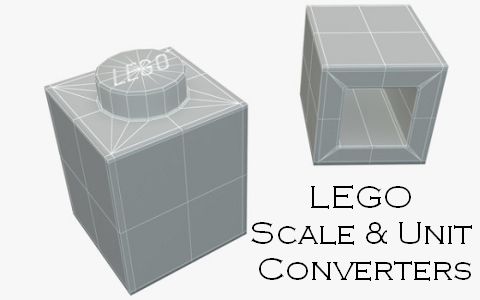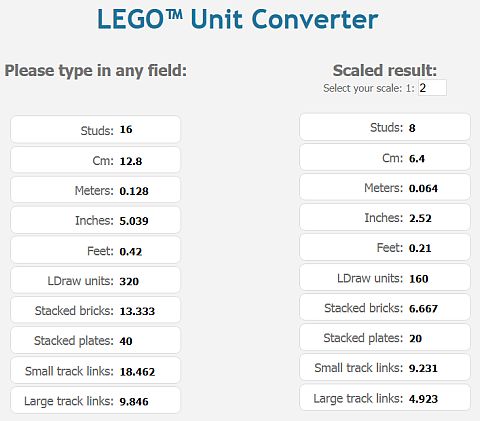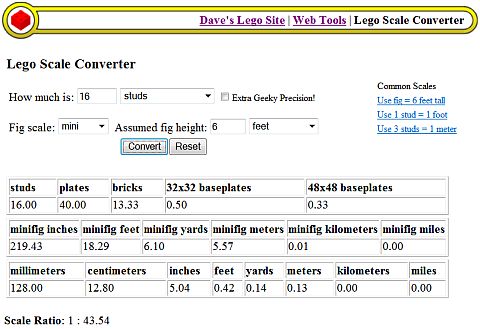If you are building large LEGO dioramas or scale models, a LEGO scale converter can come very handy. For example if you would like to build a scale model of your house, a LEGO scale converter can help you figure out how large each section of the house needs to be when you build it from LEGO elements without loosing accuracy. And you can also work within the world of LEGO – like for example if you would like to figure out how large a structure needs to be compared to a minifigure, you can calculate that too. There are two excellent LEGO scale converters that I wanted to share with you today, and I think you will find very helpful. 🙂

➡ LEGO UNIT CONVERTER: This online tool was developed by Polish LEGO fan Paul Kmiec (a.k.a. Sariel). It is a simple but very effective unit converter for LEGO studs, bricks and tracks as well as for metric and imperial systems. All you have to do is enter the desired value for a unit of your choice, and the equivalent will be shown for all the other units. These include LEGO studs, centimeters, meters, inches, feet, LDraw units, stacked LEGO bricks and plates, and LEGO tracks of both types. The converter also shows scaled results for a specified scale in the right column. The scaled results are updated whenever you change any value in the left column or the sale factor. Here is the link: LEGO UNIT CONVERTER

I use this LEGO scale converter quite often, in fact I have it added to my browser for quick access. Please note that some values may be slightly inaccurate because of internal rounding that is performed during calculations – for example you can get 0.999 instead 1. According to Sariel this issue may be eventually solved, and also he may add more units to the calculator in the future. But even now it is excellent.
➡ LEGO SCALE CONVERTER: This online tool was developed by Dave Eaton (a.k.a. DaveE) and basically does the same calculations as the converter above, however it has additional useful measurements based on the size and scale of either standard LEGO minifigs or LEGO Technic figures. With this feature you can find out things like how many studs is a mile in minifig scale and such. Although here the measurements are also rounded up by default, there is a checkbox if you would like very precise conversions. Here is the link: LEGO SCALE CONVERTER

This calculator is excellent when you are working in LEGO minifigure scale, or would like to convert real life structures and landscapes into minifig size. I have this one bookmarked as well for quick reference. As you can see both calculators cover some of the same basic measurements and also have some nice features on their own, so it is a good idea to know about both of them.
What do you think? Have use used either of the LEGO scale converters before? Any other ones that you are aware of? Or do you use your own system for converting measurements and scales? Feel free to share and discuss in the comment section below! 🙂
And you might also like to check out the following related post:












Interesting! I have started an LDD project a few years ago of building my house in Lego, but gave up as nothing met my proportions. This looks like it will help a lot, and also with my Lego speed unit “studs per second.” But for that I need to find out how long a stud is in millimeters first. 😕
I see that Sariel’s converter is more precise than Dave’s, as it goes out to the thousandths place. So I might bookmark that one, if I ever get on with any of my projects. 😐
Yes, it is worth to save them even if you don’t need such a tool now. Studs per second… interesting…
Yes, just now I was doing some conversions and measuring, and I found just how fast you have to go in order to move the distance of 1 stud in 1 hour. It’s pretty small! 😀 But now I’m confused; here’s why:
-I measured a 1×1 brick, and got .8cm, or 8mm.
-After researching on Brickset, I found that 1 stud is 7mm long, by tyre width.
-Then, I checked this site, and that picture of Sariel’s converter says that a stud is .8cm long!
So who is right? 😕
Well, I just measured it myself and it comes to 8mm. Tires may not necessarily be the same. Also tires use rubber, not ABS plastic with less of a precision that then more rigid ABS plastic would.
Yeah, but I didn’t measure the tire. Brickset says that the tyre is 14mm wide. But I think I see the error. The Entire wheel is 2 studs wide, and the holes on the hub piece stick out a bit. The sticking-out part should equal 2mm, making the total 16mm, or 2 studs. That fixes it. 🙂 I’ll have to redo my measurements tomorrow. 😐 I’ll share when I’m done. 😉
That actually sounds like a reasonable explanation.
As have been noted before, one problem with “minifig scale” is that minifigs are uniform and approximative. It would only work in practice if everyone on earth was built like Oliver Hardy…
I remember one converter that recalculated the scale of the build depending on how tall a representive human would be in cm or inches. I have forgotten the link now, though.
You can do this in the second calculator. You can choose what size you want a minifig to represent. 😉
I’ve always done this longhand in the past. Eg converting a railway station that is 370m long (from the blueprints) to a 96 stud length to then work out the m per stud for scale.
I can do the maths reasonably easily (Im a statistician among other things) but this looks a heck of a lot easier! Thanks for the links.
Tom, you are very welcome. Yes, they do make conversions easier.
I don’t do much to scale but I think having these measurements would be helpful. I’ll have to sit down a take a look. For some reason the link to the second one didn’t work for me. Not sure why. Could be just me.
Hm… I see that. It is possible that our traffic overwhelmed his server. I hope it will be back up soon. 😕
Hello, I found the converters helpful. I’m trying to make one of my mini figures into a large model. Any help advice as to start building? I can’t really seem to find any templates
Thanks
Jillian, what size are you planning to build?
What ever it can find, hoping 2 ft tall
*i darn auto correct
Problem. You need to account for the gap between pieces.
This is especially relevant for using SNOT techniques over any significant distance (the two studs/five plates ratio only works because of a little ‘give’ with the pieces) but also affects how many plates you can stack next to a stack of bricks, or even wall panels; worth considering.
Al that math made my head hurt! 🙄 But very interesting, but seems to technical for me, (never been very good with measurements)not really for me but a useful tool for others! 😀
I spent some time trying to figure out a sensible scale for mf. This information helps me a lot. Thank you!
Nakula, you’re very welcome! 🙂
Hello. thanks for the useful info on ‘converters’ !
I am in the process of building a virtual (Stud.io) scale accurate Lego model of an underground oil storage reservoir. The standard “1×1” Lego brick is used as the scale basis for my model. Therefore i have adopted a scale of 1×1 Lego brick = 1ft (wide) x 1ft (deep) or in metric, 300mm (wide) x 300mm Deep) x 375mm (high).
This ‘unit’ scale system has worked out very well (so far).